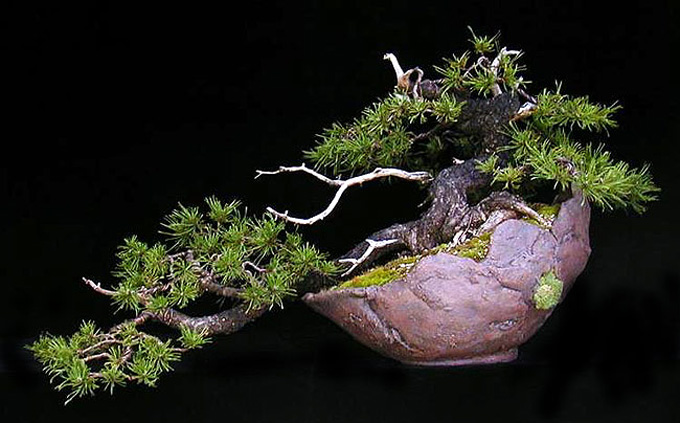
This powerful, well groomed yet craggy Mugo pine jumps off the page. It would be exceptional even if it didn’t have that wild and strange piece of deadwood that doubles back on the trunk; a feature that makes this tree uniquely distinctive and even more wonderful than it would be anyway (though I might remove the straight stick at the end that goes behind the trunk).
I might also take issue with the crown; it’s a touch too perfectly groomed and symmetrical for my taste, but still, this is an exceptional bonsai. Worthy of the finest collections anywhere. I found it in Carlos van der Vaart’s photos (facebook).
Why not Mugos?
Why haven’t Mugo pines received their due in bonsai circles? One glance at the trees in this post and you can see that they’ve got everything they need. Small tight needles, funky bark, great deadwood, gnarly shapes… the whole package.
To be blunt…
… Mugos aren’t from Japan. For a long time, the Japanese set the tone for bonsai (for good reason) and their bias is for the trees they know. This is especially true when it comes to pines, and, without a doubt, they’ve got great pines in Japan. Especially their famous Japanese black and white pines (speaking of; our Pine book is coming back soon).
Slowly but surely…
… people are recognizing Mugos for what they are. Especially in Europe, where they grow wild. If you need any evidence, take a look at these two great yamadoris (collected trees).

This craggy European beauty is from Wolfgang Putz’s most excellent website. Its natural come-as-you-are feel reminds me of Dan Robinson’s North American bonsai (Gnarly Branches, Ancient Trees).
As an American, I’ve mostly seen bushy pincushion mugos that only have their needle size to commend them. I’ve seen a few in landscapes that are pretty interesting but the reason mugos are great is because of those that grow in the Alps. Much like saying that Ponderosas have only caught on in North America. They’re great here but that’s because they grow on mountains here.
Yamadori pines are just plain exciting.
I’m having fun with Lodgepole pines here in Oregon. They have the same needle length as Mugos and they grow in the mountains all over the West, and sometimes in fantastic shapes. They typically lend themselves to Bunjin. But I’d love to have one of those wild mugos…
Hi Al,
Too bad it’s so difficult to import plants into the US. Otherwise, you could have one of those wild mugos (provided you could pay for it). That difficulty importing (draconian FDA rules) is one of the reasons US bonsai seems to lag European bonsai. The rules for importing from Asia to Europe are much laxer.
Wayne,
I agree with you on the crown being too symmetrical and removing the straight stick deadwood.
I have several mughos in my collection: the Gnome dwarf variety grafted on a trunk 18 – 20 ” tall – Black Pine I think. They were patio “poodle” trees 20 yrs ago. The tall trunks let me work with them. The majority are “pin cushions” and hard to make into anything. Very cool I paid $10 for them. Mughos get scale if you’re not watching them. Di-syston as a powder systemic applied to the soil a couple times a year seems to control it. Don’t let your dog drink the water as it drains from the pot after watering. It is poisonous.
I believe that our own native junipers, Ponderosas, Lodgepoles, spruces, oaks, maples, and other natives are every bit as compelling as mugos. Just look here! http://www.bonsaimirai.com/category/gallery/works-in-progress/
I think the status of a country’s bonsability should be gauged on how well the artists develop their own indigenous species, and how many of them are doing so. That puts Japan and China in the lead because they have time on us, but considering that it takes only 15-20 years or so (right?) to develop a truly fine, well ramified bonsai, then theoretically it shouldn’t take too long to “catch up,” if, as I read, the Japanese are to a degree losing interest in the art. I imagine that with the westernization of China (maybe Korea and Vietnam too?), bonsai will decline there as well.
Thanks Al,
Ryan’s trees are inspiring. Thanks for the tip.
I wouldn’t write the Japanese or other Asians off yet (think Indonesia and Taiwan), though there is no doubt that enthusiasm is very high elsewhere.